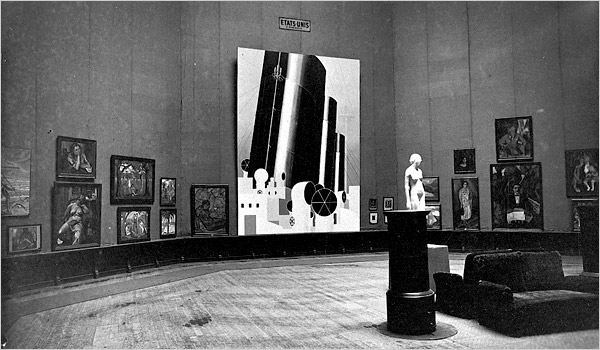
I thought about it again after seeing Nicole Eisenman’s fantastic, crisp, woke paintings at Anton Kern. But the first time I wanted to remake a destroyed Gerald Murphy painting was in 2011, sometime after seeing the photo of Boatdeck, the epic 18×12-foot canvas he pwned the Salon des Indépendants with in 1924
Boatdeck dominated and outraged the Salon with its scale, style, and subject matter, and led to the resignations of several selection committee members. Murphy made a small number of normal-sized and amazing paintings for several years, but stopped in 1929, when his son got tuberculosis and the stock market crash threatened his family business. Boatdeck is one of eight that were lost or destroyed.

Boatdeck, 1924, photo: Gerald & Sara Murphy Collection, Beinecke Library, Yale
In 1921 Gerald Murphy and his wife Sara got their start collecting, then painting scenery for the Ballets Russes. It’s where they met their painting teacher, the exiled Blau Reiter and Futurist Natalia Goncharova. Genial, rich, and happy to work for free, Gerald would touch up backdrops and such by Diaghilev collaborators like Goncharova, Matisse, and Picasso.
The biggest Picasso in the world is a curtain for “Parade,” a 1917 production for which the artist also designed the costumes, and Cocteau and Satie the music. It inspired Apollinaire to coin the term sur-realisme. The 11×14-meter curtain was shown at the Pompidou Metz in 2012.

The biggest Picasso I’ve ever seen, though, wasn’t even painted by him. Le Train Bleu (1924), is a 10×11-meter curtain created by Prince Alexander Schervachidze, another Russian exile, who enlarged a Picasso gouache so skillfully that the artist decided to sign it. Le Train Bleu was a ballet about the flashy, new, beachy Cote d’Azur lifestyle, and had costumes by Coco Chanel. It was not really a hit.
And it was Picasso’s last collaboration with Diaghilev, who nonetheless kept using that curtain all the time. It is pretty beat, especially compared to everyone’s favorite Picasso Ballets Russes curtain, le Tricorne (1919), which used to live in the hallway of the Four Seasons.
Train Bleu and Goncharova’s amazing 1926 backdrop for The Firebird were the climaxes of the National Gallery’s 2013 exhibit of the Diaghilev/Ballets Russes collection of the V&A. They absolutely dominated their galleries in the North Tower, which was then closed for gut renovations. The museum’s hilarious no-photo policy for the show left me with nothing but sneaky, wonky pocket shots of the painting’s feet. But it is awesome, and it made me want to remake things with brushes the size of brooms, too.
Skip to content
the making of, by greg allen
